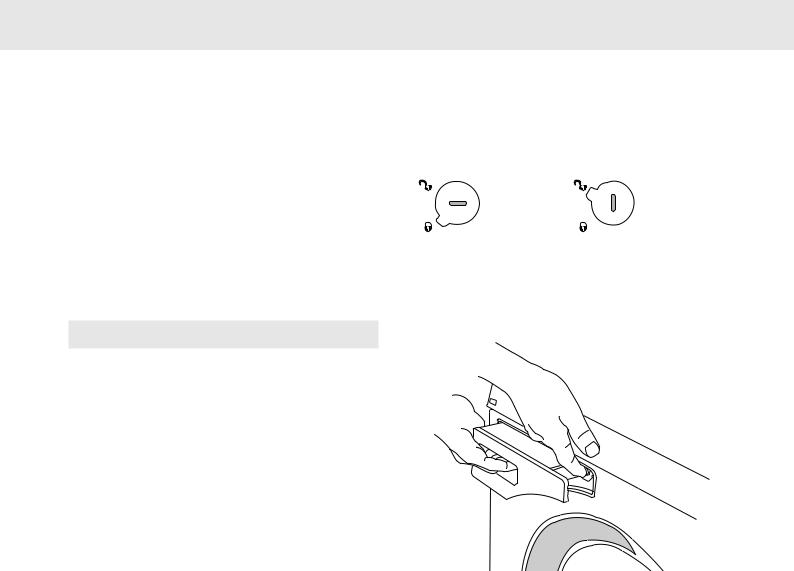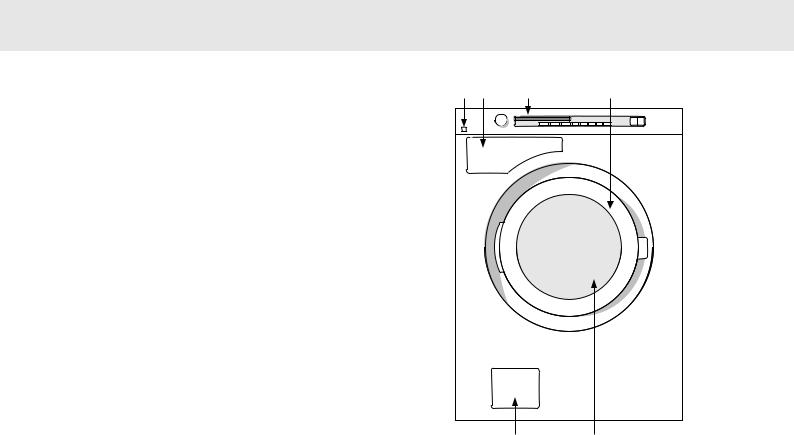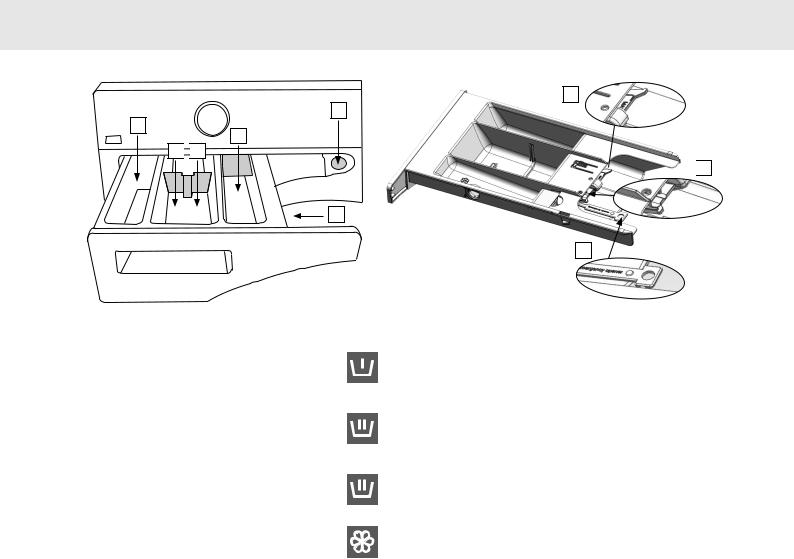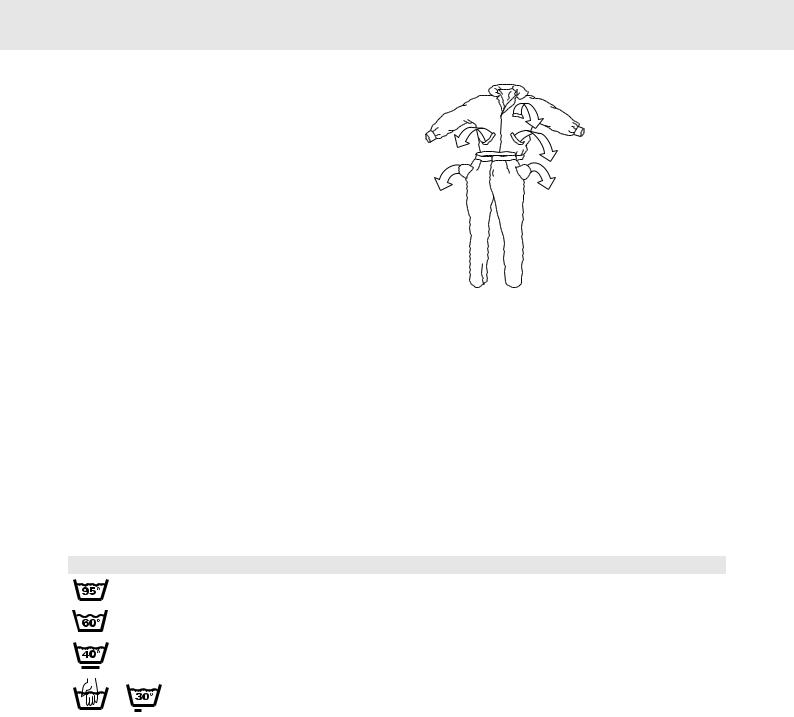ASKO W6864 User Manual

Dear Customer,
Thank you for choosing this quality product from ASKO.
We hope it will meet your expectations and fulfil your needs for many years to come. Scandinavian design combines clean lines, everyday functionality and high quality. These are key characteristics of all our products and the reason they are greatly appreciated throughout the world.
To get the most out of your new machine, we recommend that you read the operating instructions before using the machine. The operating instructions also include information on how you can help protect the environment.
Operating Instructions
Washing Machine
ASKO W6864W

Contents
Before using your machine for the first time
Transport protection Packing material Washer door Language selection
Checking water hardness
Safety instructions
General
Installation
Overflow guard function
Transport/Winter storage Recycling
Child safety
Keep an eye on children!
Description of the washing machine Dispenser
Advice and tips before washing
Sorting your laundry Clothing
Laundry labels Coloured cotton Unbleached linen Laundry label symbols
Advice and tips before washing
Wool
Rayon fibres and synthetic fibres
Reducing allergic reactions Save time and energy High water level
Economy and efficiency
Detergents Dyeing fabrics
4 |
Washing |
11 |
|
Sort your laundry. |
11 |
||
4 |
|||
Turn on the main power switch |
11 |
||
4 |
|||
Open the washer door and load the |
11 |
||
4 |
washing |
||
4 |
Add detergent and fabric softener, as |
11 |
|
4 |
required |
||
Program selection |
12 |
||
5 |
|||
Selecting options |
15 |
||
5 |
|||
Close the washer door and press the |
|
||
5 |
17 |
||
Start button |
|||
5 |
Once the program has finished |
17 |
|
5 |
Settings |
18 |
|
5 |
You can change the following settings |
18 |
|
6 |
|||
Child-safe |
18 |
||
6 |
Language |
18 |
|
7 |
Temperature |
18 |
|
8 |
Extra rinses |
18 |
|
Care and cleaning |
19 |
||
9 |
|||
Cleaning the trap and the drainage pump 19 |
|||
9 |
|||
Cleaning the detergent compartment |
19 |
||
9 |
|||
Cleaning the outside of the machine |
19 |
||
9 |
|||
Cleaning the inside of the machine to |
|
||
9 |
20 |
||
avoid unpleasant smells |
|||
9 |
Rinse holes under the agitator |
20 |
|
9 |
If you have hard water |
20 |
|
10 |
Troubleshooting |
21 |
|
10 |
The washer door will not open |
21 |
|
10 |
The machine will not start |
21 |
|
10 |
After power failure |
21 |
|
10 |
Wet washing still in the machine |
21 |
|
10 |
Error messages |
22 |
|
10 |
|
|
|
10
10
2

Contents
Technical information |
23 |
Information for test institute |
23 |
Energy labelling |
23 |
Technical data |
25 |
Transport protection |
26 |
Installation |
27 |
Positioning the washing machine |
27 |
Adjusting the feet |
27 |
Connection to water supply |
27 |
Drainage connection |
28 |
Electrical installation |
28 |
Service |
29 |
Before contacting the service division |
29 |
Quick guide |
32 |
WARNING: Read the instructions before using the machine.
3

Before using your machine for the first time
Transport protection
Remove any transport protection devices before installing the machine. See the "Transport protection" chapter.
Packing material
Please sort waste materials in accordance with local guidelines.
Washer door
•The machine cannot be started when the door is open.
•To open the washer door while a programme is running, see "Close the door and press the Start button" in the "Washing" chapter.
Language selection
You will be prompted to select the display language when you have connected your machine and start it for the first time.Do as follows:
1.Turn the programme selector to choose from: US English, English, Svenska, Dansk, Norsk, Suomi, Français, Deutsch, Italiano, Espanol,
Русский, Nederlands.
2.Press Start once to save the setting.
Checking water hardness
The quantity of detergent needed depends, amongst other things, on how hard the water is. See the detergent pack for details. Phone your local water company to check the water hardness in your area.
NOTE!
Each machine is tested before leaving the factory.
A small amount of water may remain in the drain pump, though this does not affect quality or damage the machine.
See Quick guide on the last page
4

Safety instructions
General
•Read the operating instructions and keep them in a safe place.
•Installation should be carried out by qualified
ASKO technicians.
•The machine should only be used for washing items as described in these instructions. It is not intended for dry cleaning.
•Use only detergent intended for machine washing!
•Use only detergents and softeners for machine wash. Manufacturer may not assume responsibility for any damage and eventual discolouring of gaskets and plastic components as a consequence of incorrect use of bleach and/or colouring agents.
•Never use detergents containing solvents, since there is a danger of creating toxic gasses which may damage the machine and result in ignition or explosion.
•Remove any transport protection devices before using the machine. See the "Transport protection" chapter.
•Repairs and maintenance must be carried out by a qualified professional.
•Damaged mains cables must only be replaced by a qualified electrician.
•The machine is not designed to be used by persons (even children) that are physically or mentally handicapped or lack experience and knowledge. Such persons must receive instruction in how to use the machine or be supervised by a person responsible for their safety.
•Children must be watched to ensure they do not play with the machine.
•In the enclosed plastic bag you will find a tool for opening the washer door in emergencies.
Installation
See the "Installation" chapter.
Overflow guard function
If the machine’s water level rises above the normal level, the overflow guard function begins to pump water out and shuts off the water intake.
If the water level has not dropped within 60 seconds, the program is terminated.
Transport/Winter storage
If the machine is to be transported or stored in unheated premises where the temperature can fall below freezing, do as follows:
•Empty the filter and the drainage pump.See the "Care and cleaning" chapter.
•Shut off the water to the washing machine, loosen the supply hose to the intake valve and let the water run out from the valve and hose.
•After emptying the pump, a small amount of water may remain in the machine. This does not affect quality or damage the machine.
Recycling
This machine is manufactured and labelled for recycling. In order to prevent injuries, the machine must be made unusable once the decision has been taken to dispose of it.
Contact your local authority for information about where and how your machine can be recycled correctly.
5

Child safety
Keep an eye on children!
•Always close the door and start the programme immediately once you have added detergent.
•The appliance is not intended for use by young children or infirm persons without supervision.
•Young children should be supervised to ensure that they do not play with the appliance.
•Store detergent and fabric softener out of the reach of children!
NOTE!
If this appliance is supplied from a cord extensions set or electrical portable outlet device, the cord extension ser or electrical portable outlet device must be positioned so that it is not subject to splashing or ingress of moisture.
Activate child safety catch (for detergent compartment)
On the inside of the detergent compartment is a child safety catch.
|
|
|
|
Activated child safety |
Inactivated child safety |
||
catch |
catch |
||
When the child safety catch is activated you must press the release button to pull out the detergent compartment.
6

Description of the washing machine
1 |
2 |
3 |
4 |
1. Main power switch
2. Dispenser
3. Programme panel
4.Serial number plate (on inside of washer door)
5.Drainage pump cover
6. Drainage pump (behind cover)
7. Washer door
5,6 7
7

Dispenser
A
5
1 4
2 
 3
3

 B 6
B 6
C
1. Pre-wash
2.Main wash with liquid detergent. Use the separator. (A)
3.Main wash with powder detergent. Do not use the separator.
4. Fabric softener
5.Release button
6.Child safety catch
8

Advice and tips before washing
Here are some tips that may help you before washing.
Sorting your laundry
Sort items according to:
•how soiled they are
•colour
•material
Clothing
1.Do up zips and close Velcro straps so that they don’t harm fabrics.
2.New coloured items may contain excess dye and should therefore be washed separately the first few times.
3.Turn delicate items inside out. This reduces the risk of burling and fading.
4.Empty pockets and wash them inside out if possible.
Laundry labels
Look at the item's laundry label. The table below shows suitable wash programmes for different materials and wash loads. Using modern washing machines and detergents, for example compact detergents, you can usually wash at lower temperatures. It is a good idea to use trial and error to find out what produces the best results.
Laundry label symbols
Examples of washing instructions and recommended programs. Always follow the washing instructions for each garment.
Laundry labels |
Material |
Program |
||
|
|
|
Cotton, linen, white and light-coloured items. |
Everyday wash 60 °C to 95 °C |
|
|
|
|
|
|
|
|
Cotton, linen, cotton/polyester. Light and dark-coloured garments. |
Quick 60 °C |
|
|
|
|
|
|
|
|
Acrylic, viscose, modal, acetate, polyester, polyamide and |
Easy Care 40 °C |
|
|
|
elastane. Light and dark-coloured garments. |
|
|
|
|
|
|
|
|
|
Wool, silk and other very delicate garments |
Wool/hand wash 30 °C to 40 °C |
or |
|
|
|
|
|
|
|
||
Coloured cotton
Coloured cotton items with the washing instruction 60 °C should be washed at 60 °C for the first time in order to remove any excess dye.
If you do not do so, there is a risk that the colour will run. Use detergent without bleach in order to preserve the colour of the fabric.
Unbleached linen
Unbleached linen fabrics should be washed at 60°C, using detergent containing no bleach or optical whiteners. Heavily-soiled linen can
occasionally be washed at higher temperatures, but not too often because the heat can destroy the linen’s shine and strength.
9

Advice and tips before washing
Wool
These fabrics are labelled either machine wash or hand wash.The Wool/hand wash program is at least as gentle as washing by hand.
Wool is especially sensitive to processes such as washing.
If you do not wish to spin dry, you can squeeze out the water using terry towels. In this case select No spin.
To find out how to choose this setting, see the
"Washing" chapter. However, most garments can withstand a short spin. Choose a short spin by selecting a spin speed of 800 rpm or less.
Rayon fibres and synthetic fibres
Materials made of rayon fibres, such as viscose, and some synthetic fibres are very delicate and require much space so as not to crease. Only half fill the drum when washing and choose a spin speed of 800 rpm or lower.
NOTE!
Viscose and acetates are fragile when wet.
Reducing allergic reactions
The washing machine has a Super Rinse option. Use this for people with sensitive skin, such as those with allergies and small children.
Save time and energy
Use the Everyday wash program to save time and energy.This program has a shorter main wash than Normal, but is often sufficient for lightly soiled washing.
High water level
If you want more water for the main wash and rinses, you can use the High water level option. This is automatically selected in the Wool/Hand program.
Economy and efficiency
You can save energy by not using higher temperature programs than necessary.
•Select Quick if you just need to freshen up shirts or exercise clothes, for example.This will save both water and energy.
•If you select a fast spin speed, this reduces energy consumption when drying in a tumble dryer or drying cabinet.
•Always wash with a full load when using the Heavy, Everyday wash and Normal programs.
•Avoid pre-washing. Modern machines and detergents clean effectively without prewashing. Pre-washing is only necessary for heavily soiled washing.
Detergents
Eco-labelled detergents are less harmful to the environment.
Detergent overdosing does not give better washing results; it merely causes a greater impact on the environment; can also hinder the wash performance.
Try to use less detergent, and increase only if you are not satisfied with the results.
Dyeing fabrics
If you want to dye fabrics in the machine, select the Everyday wash program with the Super Rinse option. Select temperature according to the dye manufacturer’s recommendations.
Choose a low spin speed if the fabric to be dyed is a blended material such as polyester/cotton.
NOTE!
Add the dye directly to the washing drum – not to the detergent compartment. After dyeing, you should run the machine empty using the same program. Use the normal amount of detergent.
NOTE!
Due to environmental concerns, we discourage the use of strong chemicals.
When using agents for bleaching or stain removal, there is a risk of rust (corrosion) and discolouration of the machine.
10
